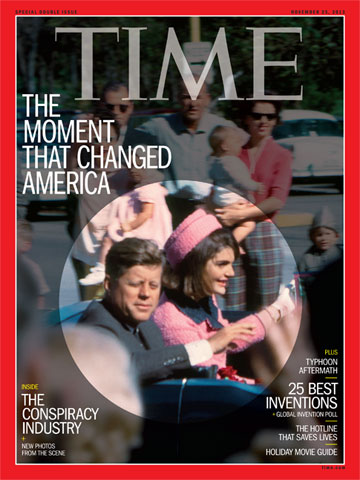
We have lived with it for half a century, and still what happened that day in Dallas is shocking beyond almost anything else in American history--by shocking, I mean it hits like a blast of electrical current and stupefies. One minute the President of the United States is smiling and waving. "Mr. President, you can't say Dallas doesn't love you!" Nellie Connally, wife of the Texas governor, calls from the limousine jump seat. A moment later, he stiffens and clutches at his wounded throat. Then his head explodes; blood and gore bathe the First Lady, who crawls onto the trunk lid of the moving car in a wild and hopeless attempt to collect the pieces.
It is one of the most brutally violent scenes ever captured on film. I won't describe it more closely, because even in print it's too wrenching. I will do as many writers have done and tell one particular detail as a way of suggesting things even worse: that Jacqueline Kennedy opened her white-gloved hand to show Secret Service agent Clint Hill the bit of skull clutched in her palm.
The victim was one of the most powerful, glamorous, wealthy, charismatic individuals on the planet. Snuffed out in an instant. This whiplash convergence of extremes--so sudden, so horrific, such enormity--makes the assassination of John F. Kennedy an almost uniquely deranging event. In a matter of seconds, the mighty are rendered helpless; the beautiful is made hideous; tranquillity turns turbulent; the familiar becomes alien.
Amid the shards of all those shattered assumptions, 50 years of doubt was born, a half-century of searching, investigating, theorizing, blame. Most Americans do not believe that what happened in Dallas has ever been properly resolved. Clear majorities--as high as 81% in 2001 and about 60% in a recent Associated Press poll--believe that a conspiracy was swept under a tattered rug. The conclusion of the Warren Commission, that one man alone delivered this devastating blow, got little traction compared with the desperate, at times unhinged, efforts to assemble a more satisfying account.
The amount of work that has gone into building, tearing down, rebuilding and ornamenting various Kennedy conspiracy theories is staggering. The number of explanations offered for that moment in Dallas is dizzying. Kennedy was murdered by a lone gunman; the Mafia; the CIA; the military-industrial complex; his own Secret Service; right-wing millionaires; Fidel Castro; Castro's enemies; Kennedy's Vice President, Lyndon Johnson. Or it was a tragic accident, and the intended target was Governor John Connally in the seat ahead of the President.
I recently waded into the thicket of theories, trying to understand the roots and fruits of this vast enterprise, which is part scholarship, part fever dream. I got just far enough to see how quickly the forest can swallow a person up. How easy it is to go from a split-second in Dealey Plaza to a fathomless argument over the windshield damage in the presidential limousine. And from there to the idea of forged autopsy documents. And from there to the notion of multiple Lee Harvey Oswalds. Or a Jesuit conspiracy. The path forks endlessly, leading everywhere and nowhere.
